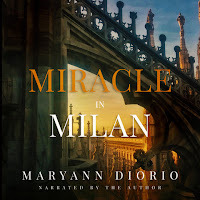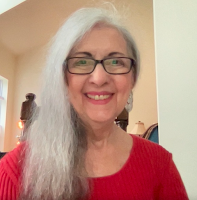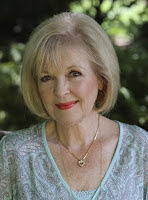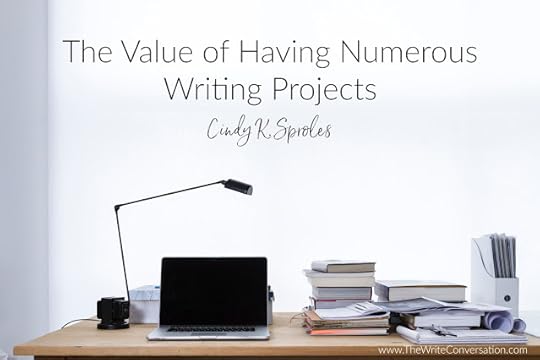Edie Melson's Blog, page 129
April 18, 2022
How to Connect with Your Readers using the Power of Emotion!

by MaryAnn Diorio @DrMaryAnnDiorio
Emotion! Emotion! Emotion!
Most of us are familiar with the expression "Location! Location! Location!" when it comes to the value of real estate. Regardless of other important features in determining the worth of a home, location is the key factor.
When it comes to writing fiction, the key factor is "Emotion! Emotion! Emotion!" It is emotion—not plot or characterization or dialogue—that ultimately determines the worth of a story to a reader. This is not to say that plot, characterization, and dialogue are not important. But, ultimately, emotion is what carries the story—and the reader.
Studies have shown that, popular opinion to the contrary, we humans make decisions based on emotion. Subconsciously, it is emotion that drives us. When we are torn between reason and emotion, emotion invariably wins the day.
You may have noticed that all advertising appeals to and targets the emotions. Most copywriters appeal to fear, greed, and lust when creating their copy. They know that if you can lasso the consumer's fears and fleshly desires, you have him.
While we, as Christ-Followers, certainly do not employ unethical methods when writing our stories, we do, nonetheless, target the emotions. Readers read for the emotional impact of a story. When they come to a novel, they are looking to feel. And to feel above all!
So, how do you make your reader "feel" your story?
Proven techniques for adding emotion to your writing:
1. Write in Deep POV. Deep POV is the technique of enabling your reader to become your character. When you write in deep POV, your reader experiences life from inside the character. He lives the story through your character's body, mind, and heart. This intimacy provides your reader with a satisfying experience whereby he discovers that, just as the character overcomes, he also can overcome.
As novelist Randy Ingermanson points out in his outstanding book, How to Write a Dynamite Scene Using the Snowflake Method, "Story is a safe way to face danger" (Ingermanson 9). Readers subconsciously read fiction to overcome fears and to solve problems. As Ingermanson further observes, "Story is what happens when you walk through great danger in somebody else's skin" (ibid.). Deep POV enables your reader to walk through conflict and danger—whether physical, emotional, or relational—in your character's skin.
2. Show; don't tell. We novelists have heard this dictum countless times, yet obeying it makes for stories that are powerful in their emotional impact. But what does it mean to show and not tell?
Showing your story instead of telling it means to relate your story through sensory details and actions rather than through exposition. When we show our story to the reader, we utilize all five senses. As in deep POV, when we practice showing instead of telling, we enter the skin of the character and become the character.
A simple way of understanding showing vs. telling is to say that showing illustrates or creates a picture while telling simply states a fact.
Here is an example of each:
TELLING: Michael was angry.
SHOWING: Michael clenched his fists and pressed them hard into his sides. His breath came in short gasps. If Jason said one more word, Michael would clock him.
Show the reader the emotion your character is feeling. Playwright Anton Chekhov beautifully describes the difference between showing and telling in his famous quote: “Don’t tell me the moon is shining. Show me the glint of light on broken glass."
3. Be specific in choosing your words to express emotion. Use strong verbs. Avoid clichés. Create original metaphors. Dig deep into your own heart and draw out the emotions connected to the experiences you have had. For example, you may never have experienced the fear of living in a war-ravaged country, but you have experienced fear.
As poet William Wordsworth advised, "Fill your paper with the breathings of your heart." When you do, your reader will be reading your pages with the breathings of her heart. And when that happens, your reader and your character will have become one.
TWEETABLEHow to Connect with Your Readers using the Power of Emotion, tips from @DrMaryAnnDiorio on @EdieMelson (Click to Tweet)
 Miracle in MilanDon't miss MaryAnn's latest audio book!
Miracle in MilanDon't miss MaryAnn's latest audio book!When a young, female auditor discovers evidence that the man she loves is an embezzler, she must choose between ruining him or ruining herself.Amy Torelli, Chief Auditor for New York City-based Enson Pharmaceuticals, is assigned to audit the books of Enson's Italian branch in the enchanting city of Milan, Italy. Having made an inner vow never to trust a man again because of her father's betrayal, Amy finds herself falling in love with Enson Italia's American-born Vice-President, Ted McMasters. Will Ted be the one to cause her to break her inner vow?Ted McMasters is on the run. A run from rejection. From himself. From God. Having been wounded by a father who made him feel worthless, and having been dumped by the woman he wanted to marry, Ted is determined to keep all women at bay. But will Amy be the reason he changes his mind?
 Dr. MaryAnn Diorio is a widely published, award-winning author of compelling fiction that deals with the deepest issues of human life. Her fiction has won several awards, including the 2020 Christian Indie Book Award for Historical Fiction, the Silver Medal for E-Book Fiction in the 2015 Illumination Book Awards Contest, and First Place for Inspirational Fiction in the 2011 Colorado RWA Launching a Star Contest.
Dr. MaryAnn Diorio is a widely published, award-winning author of compelling fiction that deals with the deepest issues of human life. Her fiction has won several awards, including the 2020 Christian Indie Book Award for Historical Fiction, the Silver Medal for E-Book Fiction in the 2015 Illumination Book Awards Contest, and First Place for Inspirational Fiction in the 2011 Colorado RWA Launching a Star Contest.MaryAnn holds the PhD in French with a concentration in Comparative Literature from the University of Kansas. She also holds the MFA in Writing Popular Fiction from Seton Hill University. A former university Professor of Romance Languages and Fiction-Writing, MaryAnn is the founder and director of The MaryAnn Diorio School of Writing. She resides with her husband in New Jersey. They are the blessed parents of two amazing daughters, a very smart son-in-law, and six rambunctious grandchildren. In her spare time, MaryAnn loves to paint in oils and acrylics, play the piano and mandolin, and make up silly songs with her grandchildren. You can reach MaryAnn at MARYANNDIORIO.COM.
Published on April 18, 2022 22:00
April 17, 2022
Accessorize Your Writing to Increase Marketing Potential

by Karen Whiting @KarenHWhiting
Adding the right tie to a man’s suit, or jewelry or scarf to a woman’s outfit can transform the piece to a fashion statement. Ties offer pops of color while other accessories complete a look. The same is true in writing. Adding the right accessories to your writing makes it pop and adds details that create a style and provide content that attracts attention. Like a scarf that can be added in multiple ways and used with other outfits, the right accessory becomes a marketing accessory from which you can get more mileage in promoting a book or a series of books.
SidebarsThe most often used writing accessory is the sidebar. These little boxes appear adjacent to the main text and add value. They add appeal and break up the text to add more white space that’s pleasing to the eye. They are separate and can often stand alone, to make perfect little marketing tools. Sidebars are also easy to write and a great tool for readers to skim when they want to find a key point in a book.
Contents of sidebars very widely from sharing information or opinions to providing tools like a recipe referenced in the text or tips on how to apply the text. They can be as short as a quote that add to reinforces the authors’ words to provide authority, to a list of steps or resources the reader can readily use. It might even be a small article that elaborates on one point or reference in th text.
Sidebars can become memes to market a book, or the main points of an article related to the book. They can give more depth to an article or book chapter that can be expanded further in a speech. In a book for raising children, my co-author added a dad toolbox box in each chapter. That made it easy for men to skim through ideas to apply and find activities to enjoy with their daughters.
Bullet PointsUsing bullet points to highlight information within a text can draw the reader’s attention and be a great way to summarize material presented. That helps readers recall the most important steps or information presented.
These lists are usually set off in the layout and thus be another way to summarize or highlight information within the text. That provides a way to highlight information that can also be a springboard for articles, talks, and social media posts. A numbered list can be done to order steps or provide excitement with a countdown list.
For a series of family devotions I wrote, I included a few sets of bulleted points for every unit. One provided simple activities to explore the week’s topis while another gave scriptures with chat prompts to engage the family in conversations that reinforced the lessons that steered the toward applications.
AddonsAdditional material at the end of a chapter offers a place and easy way to engage readers and provide action steps and applications. Repeating these tools at the end of chapters inspires readers to keep reading. Ones often used are reflective questions, pithy statements to summarize the chapter’s content, closing prayers, or action steps. Use these as part of a marketing plan. The reflective questions can become the basis of a study guide to accompany the book. Pithy statements can be turned into memes.
My family devotions ended with summary called a wrap-up. It encouraged a final discussion idea or action. These can be used as a collection of chat prompts in a sidebar of an article, or for weekly social media family chat prompts.
Charts and GraphisVisual additions to text also break up pages to add something catchy that is also informative. I added a personality chart in a Bible study for moms to help them understand their children and provide ideas for how to best help each child according to his or her personality.
Some authors have developed a basic image that shows the main concept of the book, especially if the book brings an inner transformation or promotes a basic idea to apply. This can even become a brand image. That can be seen in the recycling icon that went viral and became a symbol everywhere.
Other Accessory ElementsOther elements to add interest include solid bars to highlight headers, callouts, and other little tools that add interest to a layout. The callouts and certain highlighted text can be quotes ton post and collections of pithy statement to use in pass it on cards that promote a book. Well placed callouts can also be to set apart major talking points of a book. Those can become article prompts and ideas for potential new talks for the author.
What will you do for you current or future projects? Use the following list as a prompt in designing your book’s visual components.Sidebars to be repeated, that offer applications or more information.End of chapter addons to engage the reader and summarize major points.Charts or graphs or important information or steps to take.Background information, related recipes or activities, or other ideas to use in a sidebar or short bulleted lists within paragraphs.Have fun adding accessories to your writing to grab attention and fuel your marketing.
TWEETABLEAccessorize Your Writing to Increase Marketing Potential, tips from @KarenHWhiting on @EdieMelson (Click to Tweet)
 Karen Whiting (WWW.KARENWHITING.COM) is an international speaker, former television host of Puppets on Parade, certified writing and marketing coach, and award-winning author of twenty-seven books for women, children, and families. Her newest book, The Gift of Bread: Recipes for the Heart and the Table reflects her passion for bread and growing up helping at her grandparent’s restaurant. Check out her newest book Growing a Mother’s Heart: Devotions of Faith, Hope, and Love from Mothers Past, Present, and Future. It's full of heartwarming and teary-eyed stories of moms.
Karen Whiting (WWW.KARENWHITING.COM) is an international speaker, former television host of Puppets on Parade, certified writing and marketing coach, and award-winning author of twenty-seven books for women, children, and families. Her newest book, The Gift of Bread: Recipes for the Heart and the Table reflects her passion for bread and growing up helping at her grandparent’s restaurant. Check out her newest book Growing a Mother’s Heart: Devotions of Faith, Hope, and Love from Mothers Past, Present, and Future. It's full of heartwarming and teary-eyed stories of moms.Karen has a heart to grow tomorrow’s wholesome families today. She has written more than eight hundred articles for more than sixty publications and loves to let creativity splash over the pages of what she writes. She writes for Crosswalk. Connect with Karen on Twitter @KarenHWhiting Pinterest KarenWhiting FB KarenHWhiting
Published on April 17, 2022 22:00
April 16, 2022
The Story of Our Savior's Hands

by Edie Melson @EdieMelson
On this Resurrection Sunday, my thoughts and imaginings have turned to hands. Of course you know what started me down that path. The image of Jesus’ nail-scarred palms are everywhere. But as I reflect on those precious hands, I realize the story of our Savior’s hands begin much earlier.
I believe we see the power of His hands as He stretched them over the formless void and spoke creation into existence. We saw them as He tenderly shaped His children—man and woman—made perfectly in His own image. Then, with heart-breaking clarity, in my mind’s eye, I can see those powerful hands when they performed the first sacrifice as he provided a covering for His sinful children.
As the centuries progressed, we saw that God sometimes worked through the hands of men like Noah. God used Him to preserve a remnant of humanity when creation went so wrong. In Moses, I saw the power of God when His prophet stretched forth his hands and parted the Red Sea, providing for the salvation of His people. He was there as Joshua defeated Jericho and with Gideon as he discovered his own part in God’s plan. We saw the fingerprints of God working throughout the Old Testament—from Elijah to Elisha, Job to Josiah. He was always present— rebuilding, refining, remonstrating and renewing those He loves.
Then it happened. God’s Spirit descended and touched a young girl and Mary was with child—destined to give birth to the Son of God. As her time drew near, we saw how God’s loving hands worked through Joseph as he protected his wife, delivered his infant son, and cared for them.
When Jesus began His time of ministry, we once more saw the work of God’s hands. He was everywhere. He touched the untouchables and encouraged a dark world to refocus on God’s light. His hands were love in action, serving and sharing; reaching out and sometimes rebuking; comforting and consoling; protecting and proclaiming—and always forgiving.
Finally, we see the ultimate sacrifice as He stretched out those hands and took the punishment I deserved. His hands were pierced instead of mine. He was the one ridiculed and beaten instead of me. Those precious hands ran red as the life-giving fluid was poured out for me.
But that’s not the end of the story.
In God’s word, we see how Jesus defeated Satan and death. Proving once and for all His hands are mighty to save.
He commissioned His disciples to carry on the work of His hands. That command hasn’t changed. Now it’s His people who reach out their hands in His name. We are called to love in action, serving and sharing; reaching out and sometimes rebuking; comforting and consoling; protecting and proclaiming—and always loving and forgiving.
Yes, Easter Sunday morning is a time to rejoice. But it’s also time to reflect and recommit to being God’s hands—touching the untouchables and encouraging a dark world to refocus on God’s light.
Lord, Your right hand is glorious in power. Lord, Your right hand shattered the enemy. Exodus 15:6
TWEETABLEThe Story of Our Savior's Hands, from @EdieMelson (Click to Tweet)
 Edie Melson is a woman of faith with ink-stained fingers observing life through the lens of her camera. No matter whether she’s talking to writers, entrepreneurs, or readers, her first advice is always “Find your voice, live your story.” As an author, blogger, and speaker she’s encouraged and challenged audiences across the country and around the world. Her numerous books reflect her passion to help others develop the strength of their God-given gifts and apply them to their lives. Connect with her on her website, through Facebook, Twitter, and Instagram.
Edie Melson is a woman of faith with ink-stained fingers observing life through the lens of her camera. No matter whether she’s talking to writers, entrepreneurs, or readers, her first advice is always “Find your voice, live your story.” As an author, blogger, and speaker she’s encouraged and challenged audiences across the country and around the world. Her numerous books reflect her passion to help others develop the strength of their God-given gifts and apply them to their lives. Connect with her on her website, through Facebook, Twitter, and Instagram.Featured Image: Photo by Billy Pasco on Unsplash
Published on April 16, 2022 22:00
April 15, 2022
Why We Write

by Emme Gannon @GannonEmme
Tomorrow is the glorious celebration of Easter, the resurrection of our Lord and Savior Jesus. We will gather and remember Jesus’ holy act of love and sacrifice. For God so loved us that He sent His only Son to suffer and die for our sins so that we who believe can have eternal life. That life of eternal living begins when we believe. That means that even when our bodies leave this earth, the part of us that thinks and feels emotion lives on—alive with Him and all those who have gone before us.
His gift of mercy and grace extends beyond His sacrifice on Calvary. Nine days after His ascension into heaven, He sent His Holy Spirit to dwell in the spirit of the believer, to strengthen, equip, renew, and reveal His truth. He did this, knowing we are but dust and would continue to fall short. His grace—God’s unmerited favor to those who believe—sustains us as we live our days on this earth.
A Holy Commission
This is the God we serve. This is the One who calls us to write. This is the Lord who gives talents and then says, Follow Me. Each of us are called to a different and unique task. It is His truth we unashamedly proclaim in our words and stories. This is our calling. Our mission. We write the same song with different words and different voices, but always grounded in uncompromising truth.
God Uses Our Struggles
“The author who benefits you most is not the one who tells you something you did not know before, but the one who gives expression to the truth that has been dumbly struggling in you for utterance.” Oswald Chambers
Often our words come from a place of profound pain. As we struggle to make sense of tragedy, we infuse our characters with similar struggles, often striking a cord of recognition in the hearts of our readers—revealing inherent beliefs within so that those who read will come away different, their soul touched, their eyes open to a new and more refined light.
Reveal The Hidden Words
If we feel incapable of this great calling, we’re not alone. We must remind ourselves that God works through flawed humans. It’s then we take a deep breath and yield our fears and concerns to God, who happily takes them unto Himself. Then, we sit back at the computer and trust Him. He who called us will not forsake us. There are stories deep inside of each of us that are waiting to be told—words that keep begging for life, but we turn away in fear.
As we celebrate the resurrection of our Lord and Savior Jesus, it is my prayer that we also allow those hidden words to come forth in life. He who is life will breathe life into the work He has called you to do. You’ve only to roll away the stone. See, the tomb is empty. He has risen and His spirit dwells in the spirit of each of His children, equipping us to be that “Living letter from Christ to the world.” (2 Corinthians 3:2)
“O God, early in the morning I cry to you.Help me to pray, and to concentrate my thoughts on you.I cannot do this alone.
In me there is darkness,But with you there is light;I am lonely, but you do not leave me;I am feeble in heart, but with you there is help;I am restless, but with you there is peace.In me there is bitterness, but with you there is patience;I do not understand Your ways,But you know the way for me . . .
Restore me to liberty,And enable me so to live nowThat I may answer before You and before me,Lord, whatever this day may bring,Your name be praised.Amen”
Dietrich Bonhoeffer (1906-1945)
TWEETABLEWhy We Write - thoughts from @GannonEmme on @EdieMelson (Click to Tweet)
 Emme Gannon is a wife, mother, and grandmother who loves to write stories that stir the heart. Her award-winning writing has appeared in Focus on the Family magazine, several anthologies, and numerous newsletters. She just completed her first novel.
Emme Gannon is a wife, mother, and grandmother who loves to write stories that stir the heart. Her award-winning writing has appeared in Focus on the Family magazine, several anthologies, and numerous newsletters. She just completed her first novel.
Published on April 15, 2022 22:00
Addressing Tough Topics when Writing Children’s Books

by Crystal Bowman
As our society becomes more aware of social, physical, and ethnic diversity, book for children need to reflect that reality. Books about children with special needs is a needed topic in today’s market. Publishers, however, are reluctant to accept these stories because they believe the market is too narrow. Stories that feature a child with Down Syndrome, autism, or a physical disability can be a great resource to help kids understand that all children desire and deserve to be included and treated with respect. But these are not your typical bedtime storybooks that children want to hear.
Another difficult topic is the death of a sibling, parent, grandparent, or even a pet. Though these stories can be comforting and helpful, unless the stories are relatable and needed at a particular moment, parents won’t look for them, and you’ll rarely find them on the best-sellers list.
Stories about child immigrants and refugees are becoming more popular. These stories, though needed and informative, are not necessarily fun to read. I’m writing the true story of a young girl who was forced out of her African village because of war and spent her childhood in a refugee camp. It’s a beautiful, heart-tugging story filled with God’s love and protection, but escaping war is not a desirable subject for most children.
In 2020, I published I Love You to the Stars, When Grandma Forgets, Love Remembers . Inspired by a true story, it addresses the topic of dementia. The manuscript was applauded and praised by every publisher who read it but decided to pass. Eventually, Kregel Publishing saw value in this story and published it. The book has received four prestigious awards, dozens of five-star reviews, and was a #1 new release on Amazon. Everyone knows someone who is affected by memory loss, and this book is a great resource to help children understand the disease, but sales are just okay.
How can we address hard topics in a way that will reach today’s market?
One way to address harder topics is to weave them into a book of devotions for children. Writing a devotion about children being uniquely created by God is a positive way to talk about children with special needs. A devotion about God comforting us when we’re sad can address the loss of a loved one. A devotion about God being with us wherever we go can address the topic of moving away from home. When the devotions are added to broader compilation, written with age-appropriate language, and end with hope, the messages can be well received by a child.
Publishers are also more intentional about portraying diversity and inclusion in illustrations. Bi-racial, multigenerational, and single parent families are more common, and characters can also be illustrated showing a physical disability. Michelle Lazurek and I have a picture book releasing this fall about four young girls who dream of their future careers. Each character represents a different ethnicity, and one of the girls has one arm. She engages in activities just as the other girls do, and there is no mention of her “one arm” in the text. She is portrayed as equal to the other three girls.
In the picture book, Different Like Me , (Our Daily Bread) Xochitl Dixon features a diverse group of children celebrating their differences and realizing what they have in common. The illustrations tell an adventurous second story as the children work together on a common goal of transporting a giant fish balloon. Children will enjoy the book as they learn about our differences through a delightful story.
How to publish a “tough topic” book.
If you’re interested in writing a book on a difficult subject, indie publishing, or partnership publishing may be the best choice. With print-on-demand options, authors can commit to a realistic quantity of books and print more when needed. Promoting the book through local organization, bookstores, schools, churches, and library visits are ways to reach an audience. By talking about the purpose of the book and offering insightful or educational backstory, your audience will be more interested in purchasing a copy for themselves or for someone else.
Our world is constantly changing and the books we write can reflect those changes in a positive way while honoring our Creator. Writing is hard and writing about tough topics is even harder. But if tough-topic books offer insight, hope, and awareness, then they need to be written.
TWEETABLEAddressing Tough Topics When Writing Children's Books from Crystal Bowman on @EdieMelson (Click to Tweet)
 Crystal Bowman is an award-winning, bestselling author of more than 100 books for children and four nonfiction books for women. She also writes lyrics for children’s piano music and is a monthly contributor to Clubhouse Jr. Magazine. She loves going to schools to teach kids about poetry. She also speaks at MOPS (Mothers of Preschoolers) groups and teaches workshops at writers’ conferences. When she is not writing or speaking, she enjoys going for walks, working out at the gym, and eating ice cream. She and her husband live in Michigan and have seven huggable grandkids.
Crystal Bowman is an award-winning, bestselling author of more than 100 books for children and four nonfiction books for women. She also writes lyrics for children’s piano music and is a monthly contributor to Clubhouse Jr. Magazine. She loves going to schools to teach kids about poetry. She also speaks at MOPS (Mothers of Preschoolers) groups and teaches workshops at writers’ conferences. When she is not writing or speaking, she enjoys going for walks, working out at the gym, and eating ice cream. She and her husband live in Michigan and have seven huggable grandkids. WWW.CRYSTALBOWMAN.COMWWW.FACEBOOK.COM/CRYSTAL.BOWMANWWW.FACEBOOK.COM/CRYSTALJBOWMANWWW.INSTAGRAM.COM/CRYSTALBOWMANAUTHOR
Published on April 15, 2022 09:52
April 13, 2022
Is Social Media a Good Investment for Writers?

by Edie Melson @EdieMelson
The short answer?
It depends.
Social media. Often just the mention of this subject conjures up hours of time. First there’s the time it takes to hang out online, then the time it takes to figure out what to say, who to LIKE and which updates to comment on, share and even retweet.
Is there a chance that someone out there in cyberspace might actually—either now or sometime in the future—buy a book?
Or is it true that editors and/or agents ijudge the number of friends, followers and likes I have on my social media network and decide from that whether or not I'm a reasonal investment?
These questions beg answering!
I’m sure many of you already have an answer. And you’re hoping I can either justify your opinion or make a legitimate case to change your mind and show you how easy and how much fun it is.
The truth is this: Social media is hard work. It takes being intentional and keeping your goals in mind.
And those goals are what can get us in trouble.
I think most people approach social media with the wrong goal in mind and that leads to frustration.
Social media isn’t advertising and, although we do have the possibility of reaching millions, it’s not mass marketing.
Social media is a way of connecting with people online—in this day and time, it’s a large part of building meaningful relationships and making lasting connections.
Beyond that, for writers, social media is a tool. It’s an important tool, but it’s one of many we use when we’re professional writers.
Valuable Social Media Goals for Writers 1. We want to connect with others online in a way that has meaning. It doesn’t have to become a deep friendship, but it should be a way to enrich one another’s lives.
2. We want to add value to the lives of those we connect with. This means we don’t want to just be part of the online noise, but actually make a contribution.
3. We want to find people we can encourage and who can (and will) encourage us. These people will help share your excitement when a book comes out, and they’ll also be there when things don’t go as planned.
4. We want to be authentic online. We want people to recognize us face-to-face, not just because our image looks like us, but because our updates and online interactions sound like us.
5. We want to have a positive impact on the world—online and offline. To do that, we need to be visible and able to be found.
6. We want to always put others ahead of ourselves. We do this because it’s the right thing to do, and because it helps prove that we’re not just here to get what we can from people and move on.
None of these 6 goals is directly related to selling books—but they can all impact our book sales. If all we’re trying to do is be online to garner huge numbers and sell a product, we’d be better off spending the money on direct advertising.
So what do I share online to accomplish these 6 goals? I have four specific types of updates I share.An inspiring and/or thought provoking quote or a Bible verse.Something humorous (because laughter is the best medicine and we really can’t have too many funny cat videos!)A question, usually thought provoking, but sometimes related to something I need an answer to.A link to something I’ve found valuable or interesting somewhere online.
I definitely think social media is worth it.
By being interested in the people I encounter through social media, I’ve managed to make lots of new friends and fun connections. I've also been blessed by the way those online support me and encourage me. I know I’d have missed out on so much, if all I’d been interested in was selling books or using those online to pad the numbers part of my platform.
Now it’s your time. What valuable connections and relationships have you found through social media. Or, if you disagree, I’d love to hear why. We can all learn from each other.
Don’t forget to join the conversation!Blessings,Edie
TWEETABLEIs Social Media a Good Investment for Writers? Insight from online expert @EdieMelson (Click to Tweet)
 Edie Melson is a woman of faith with ink-stained fingers observing life through the lens of her camera. No matter whether she’s talking to writers, entrepreneurs, or readers, her first advice is always “Find your voice, live your story.” As an author, blogger, and speaker she’s encouraged and challenged audiences across the country and around the world. Her numerous books reflect her passion to help others develop the strength of their God-given gifts and apply them to their lives. Connect with her on her website, through Facebook, Twitter, and Instagram.
Edie Melson is a woman of faith with ink-stained fingers observing life through the lens of her camera. No matter whether she’s talking to writers, entrepreneurs, or readers, her first advice is always “Find your voice, live your story.” As an author, blogger, and speaker she’s encouraged and challenged audiences across the country and around the world. Her numerous books reflect her passion to help others develop the strength of their God-given gifts and apply them to their lives. Connect with her on her website, through Facebook, Twitter, and Instagram.
Published on April 13, 2022 22:00
Writers, How Does Your Garden Grow?

by Julie Lavender @JLavenderWrites
Every evening recently, my nature-loving hubby, a biologist by trade, spends hours in the backyard turning soil, mulching leaves, spreading seeds, potting plants, and weeding. David carefully chose plants and packets designed to attract butterflies and hummingbirds.
For the sake of our favorite surname, David picked three varieties of lavender and gingerly placed them in the soil. He chose butterfly weed in shades of amber, tangerine, and marmalade, which according to the package will display a “fiery floral sunset” in my yard.
David planted a creeping vine, cardinal climber, that promises shades of scarlet and vermilion. Blue carpet lobelia offers splashes of cobalt and azure. Three colors of salvia add additional shades of red, blue, and lavender.
David tucked dill and parsley in the soil because both are the host plants for black swallowtail butterfly caterpillars, and stuck a paw paw tree seedling in the ground because it is the host plant for zebra swallowtail caterpillars.
For good measure, my biologist planted pink bee balm and sprinkled seeds from packets labeled “bird and butterfly mix” and “hummingbird mix.”
When God adds warm days and April showers to David’s hard work, my backyard will be a plethora of pretty, an array of colors to attract a myriad of winged creatures my husband loves.
But I think the ultimate purpose of my floral garden is to bring glory to its Creator, my Heavenly Father. Though the leaves diverge into different shapes on each plant, and the blossoms vary in shape and hue, and the scents differ from bush to plant to flower, each one displays God’s magnificent handiwork. Crafted by His own hand, the flora point back to Him and sway in praise when His breath sends gentle breezes.
In just a few weeks, my backyard landscape will fulfill the promise in Psalm 66:4, Everything on earth will worship you; they will sing your praises, shouting your name in glorious songs.
As a writer who plants seeds with my words, words that I truly believe are crafted by His own hand and His breath, I believe my garden of stories and articles and devotionals offers heartfelt worship and joyous praise to their Creator. Each one of my projects differs from another in size and shape and hue and fragrance, but their ultimate purpose is to bring glory to God.
Some of my written offerings may wither or shrivel before sharing their beauty with the world, but perhaps that creation wasn’t meant to launch into the world or maybe the bloom and benefit was meant for me alone. Many of my fragrant words—my Jerusalem blossoms—will entice my family to look to the Holy One. Some of the seeds I plant will take flight and disperse to a neighbor’s yard or even across the creek to another county, my Judaea, so to speak. Like pollen carried on hummingbird beaks and butterfly wings and bumblebee legs, my words could travel to Samaria and unto the uttermost part of the earth.
And my garden won’t resemble another writer’s landscape. Which is a good thing, because who wants the boredom of every garden looking exactly the same?
Writer friend, how is your garden growing this spring? Are your words worshiping Him? Do your projects praise the Heavenly Father? Are your submissions singing glorious songs?
Offer a spectacular landscape to the Lord this spring.
PRAYAsk God what He wants you to write this season.
PREPAREDo the work to accomplish God’s purposes in your writing life. That might involve reading, researching, attending conferences, learning more about the craft from others, and a lot of writing and editing.
PLANTSend out those writing seeds, through submissions, podcasts, blogs, speaking engagements, or deadline accomplishments for signed contracts.
PRAISEWorship God with your words; praise Him with every project you pen.
Tell me about the seeds you’re planting this spring—floral ones in your backyard or figurative ones on your computer. I can’t wait to hear what colors your backyard will boast, especially if plan to grow lavender this season! And I’m even more excited to know how your words will witness in Jerusalem, all of Judaea, in Samaria, and to the ends of the earth.
TWEETABLEWriters, How Does Your Garden Grow? Insight from author @JLavenderWrites on @EdieMelson (Click to Tweet)
 Julie Lavender can’t wait for the smell of lavender to punctuate her backyard and attract a variety of hummingbirds and butterflies for regular visits. She hopes her writings offer the pleasing aroma of Christ to God, first and foremost, and then to the saved and unsaved in the world around her. She is the author of
Children’s Bible Stories for Bedtime
—that she thinks would make a wonderful Easter basket treat—and
365 Ways to Love Your Child: Turning Little Moments into Lasting Memories
. Connect with her on social media and julielavenderwrites.com.
Julie Lavender can’t wait for the smell of lavender to punctuate her backyard and attract a variety of hummingbirds and butterflies for regular visits. She hopes her writings offer the pleasing aroma of Christ to God, first and foremost, and then to the saved and unsaved in the world around her. She is the author of
Children’s Bible Stories for Bedtime
—that she thinks would make a wonderful Easter basket treat—and
365 Ways to Love Your Child: Turning Little Moments into Lasting Memories
. Connect with her on social media and julielavenderwrites.com.
Published on April 13, 2022 22:00
April 12, 2022
5 Tips to Build Your Writing Platform Through Writing Articles

by Linda Gilden @LindaGilden
I continually am amazed when I mention writing articles I get so many blank stares. It is like nobody ever thought about writing articles.
But I would love to “plant a few seeds” and encourage you to write more articles. Why would you want to do that? Any number of reasons but today we are just going to concentrate on one.
Writing articles is a great way to get your name out there and establish yourself in the writing world. If you do enough writing on he subject, you may find yourself labeled as an expert in that area. Then you can become the go-to person in your area of expertise.
If you are a new writer, this is just as much for you as other writers. For all those trying to build their platforms and find their places in the writing world,
Here are a Few Suggestions
What do you like to do? Are you a master gardener? An expert cook? Do you raise dogs or have had pets of the same breed since growing up? Do you have certain skills that could benefit others? A good place to start writing articles is to begin with a subject you know. For those of you who are book writers, maybe you can write about a subject related to your book. That way your article will serve double duty as it introduces your book to the world. If you are counting on your articles for platform building, make sure your articles in some way show you as the person you are trying to promote. For instance, if you choose to write about gardening since that is one of your favorite things to do but your platform is parent/child relationships, be sure to include a paragraph or two about that in your article.Obtain the guidelines to a periodical that would be a good fit for your article. Write your article paying specific to the magazine guidelines, and don’t think you will be the exception to the rules. Don’t just aim for the biggest magazines you can find. Sometimes a more focused publication will introduce you to a large group of readers that are well-targeted for your subject. An article can serve as an introduction to a new group of loyal supporters for you.Then write your query letter. Query letters are another subject for another time. But this is another part of article writing that requires great care. After all, this is your introduction to another group—editors of the publications. Pay close attention to your bio. Make sure you include information that will connect to the magazine’s readership. If you have a new book coming out that relates to your article, mention “Mary Smithman is the author of the soon to be released Growing Up on the Farm.” This only works if you are writing about a farm-related subject, of course. Also include that Mary often writes and speaks on the subject of parent-child relationships, thereby increasing awareness of your platform.As your name is seen more and more in the bylines of your articles, people will more frequently ask you questions about your subject. That is what you want to happen—lots of readers who see you as the expert. When that happens, you have successfully used articles to help you begin your writing career and start building a platform that will help others recognize you as a respected person in your field.
TWEETABLE5 Tips to Build Your #Writing Platform by Writing Articles, from @LindaGilden on @EdieMelson (Click to Tweet)
 Linda Gilden has coauthored 11 books with 5 different coauthors and has #12 and #13 coming out in 2022, adding a new co-author to the list. She loves every one of her coauthors and enjoys collaborating on interesting projects with them. She also has written many books on her own and realizes what a treasure and blessing a good co-author is.
Linda Gilden has coauthored 11 books with 5 different coauthors and has #12 and #13 coming out in 2022, adding a new co-author to the list. She loves every one of her coauthors and enjoys collaborating on interesting projects with them. She also has written many books on her own and realizes what a treasure and blessing a good co-author is.Featured Image: Photo by Thomas Lefebvre on Unsplash
Published on April 12, 2022 22:00
April 11, 2022
The Value of Having Numerous Writing Projects

by Cindy K. Sproles @CindyDevoted
I hear it every conference. It’s not uncommon for conferees to ask, “How many projects do you work on at once?” The number varies, but I continually have numerous writing projects that keep me busy.
Why Have Multiple Writing Projects
The short answer. I’ve learned that it’s time to move ahead when one project is complete. The long answer is that any writer needs to have a back pocket filled with possibilities and those possibilities need to be developed enough to make sense if a publisher requests them.
It’s important to have a file ready if the current project just doesn’t work. For example. My agent recently presented an entire novel and proposal to my publisher. They liked the work but didn’t see that it was a current fit. “Does she have anything in the back pocket?” My agent was happy to present them a second project “idea” that the publisher contracted. Are you seeing the importance of working on more than one idea at a time?
The next idea is there. It may not be completed, but there is enough that the publisher gets a strong idea about the project. Back pocket work is valuable, and every writer needs several.
Even if your back-pocket projects are uncompleted, you still have a nice synopsis and three chapters that you can present when asked. A proposal is not necessarily crucial at this point because publishers are simply looking at a style twist they like and if there is a project that can develop into a work that fits their needs.
I frequently see writers with one completed project who continue to pitch that same manuscript yearly. I know what they are bringing before they sit down. There is a time when an author accepts they have done their best on the project and moves ahead. Stop spinning their wheels. It doesn’t mean you give up on the project, but you lay it to the side and begin a new project while you wait for the opportunity for the first one.
As the song says, let it goooooo! Start project two. You’ve learned to write even better in project two, and maybe that story will land you an agent. That agent will ask you if you have any back pocket ideas. The why goes back up to paragraph three. Project two may be great, but it doesn’t fit the publisher’s needs. Still, they love your writing and your twist on things – it’s fresh and unique, so do you have any other projects? It would be a grave disappointment to have your agent say no to the publisher. When you hear conference teachers, agents and publishers talk about moving ahead, understand this is why.
Work on your main project to completion, but along the way, entertain those new ideas spurred as you work. Take a day to write one to three chapters while the idea is fresh in your mind. Put a brief synopsis together that describes the plotline brewing. Name the characters so that you will remember. Title it. Save it in your back pocket file. Take a break from project one and let it percolate from time to time. Work on a back pocket chapter or even a new idea in the interim. Build that reserve. Too often we have an idea that slips into la-la land because we don’t give it enough respect into developing it, so it’s useable.
Bottom LineWhen you develop back pocket projects, you are expanding your writing career. It may not be a novel or a non-fiction book, but it may be an article or a children’s story idea. Give it life and allow it to brew.
It’s easy to write one work and then get hung on just that one, never making an effort to move ahead. I’ve heard, “God told me to write this” a zillion times. And though I never doubt that God has placed that story in your heart, it doesn’t mean that this is a story He will move into publication. It may be cathartic for you, or maybe be a tremendous series of articles instead. It could actually be a subject dear to you, and you’ll stick to it to completion and “learn the craft.” The point is to continue moving. God may tell you to write something but don’t put words in His mouth as to the use. Write. Write. Write. Turn the projects over to Him and trust that His timing is perfect.
Keep those back pocket projects growing. You may be pleasantly surprised how your career begins to grow.
TWEETABLEThe Value of Having Numerous Writing Projects, tips from @CindyDevoted on @EdieMelson (Click to Tweet)
 Cindy K. Sproles is an author, speaker, and conference teacher. She is the cofounder of Christian Devotions Ministries and the executive editor for www.christiandevotions.us and www.inspireafire.com. Cindy is the lead managing editor for SonRise Devotionals and also Straight Street Books, both imprints of LPC/Iron Stream Media Publications. She is a mentor with Write Right and the director of the Asheville Christian Writers Conference held each February at the Billy Graham Training Center, the Cove, Asheville, NC. Cindy is a best selling, award winning novelist. Visit Cindy at www.cindysproles.com.
Cindy K. Sproles is an author, speaker, and conference teacher. She is the cofounder of Christian Devotions Ministries and the executive editor for www.christiandevotions.us and www.inspireafire.com. Cindy is the lead managing editor for SonRise Devotionals and also Straight Street Books, both imprints of LPC/Iron Stream Media Publications. She is a mentor with Write Right and the director of the Asheville Christian Writers Conference held each February at the Billy Graham Training Center, the Cove, Asheville, NC. Cindy is a best selling, award winning novelist. Visit Cindy at www.cindysproles.com.Photo by freddie marriage on Unsplash
Published on April 11, 2022 22:00
April 10, 2022
Four Elements Writers Can Use to Speak With Confidence
Edie here. Today I want to introduce our newest TWC columnist, LInda Goldfarb. If you've been to the Blue Ridge Mountains Christian Writers Conference, you know her as our MC. But she's a dear friend, amazing writer & speaker, and a true wealth of information. I'm so excited she's agreed to sign on and share her knowledge. Please give her a warm TWC welcome!

Four Elements Writers Can Use to Speak with Confidenceby Linda Goldfarb @LindaGoldfarb
If you write, you will eventually speak. Whether speaking on a podcast about your latest book, sharing details of your upcoming novel to adoring fans via social media, or presenting in front of a large group of fellow writers, your opportunity to speak is coming. Are you ready to speak with confidence?
Fearless Speaker or Confident Communicator?
I’ve been speaking professionally for more than three decades. Over time I've discovered speaking comes naturally to some writers but not most. You're not alone if you feel a twinge of unease when asked to speak. Glossophobia, the fear of public speaking, impacts 75% of the population. Though this fear is not life-threatening, it can affect your ability to engage at a deeper level with your readers. My goal for this post is not to eliminate fear but to encourage confidence with four elements you can include the next time you create a talk/speech.
Utilizing the L.I.S.T. speaking model can help you gain a fearless approach to speaking about the subject you love—your writing.
The L.I.S.T. Speaking Model
L.I.S.T. stands for:Life ExperienceInstructionSourceTakeaway
I use this model to help clients create their signature speeches and to write book chapters. When we implement these elements into our talks, attendees remember our message and not our mistakes.
Mental Sticky NotesEvery well-remembered speech includes life experiences. Life experiences can be personal or secondhand stories or quotes you use to affirm the point you are making with your takeaway. I love how Literary Agent, Wendy Lawton, reminds writers to “Story it up!” Stories enhance our speaking in the same way they take our writing to a higher level of excellence. Start with a story to draw in your audience, but save the key takeaway until the end. Be sure your story is relevant to your topic. A random tale or joke can make people laugh, but a closely connected story is a mental sticky note your audience will recall long after your speech is over.
Seeds-of-ConsiderationThe difference between a pleasant talk and a life-changing speech is what you ask the audience to do after leaving your keynote or teaching session. Instructions plant seeds of consideration into the minds of your audience to help them make use of what you shared.
Consider the following starters:Once you arrive home …Take three minutes right now to jot down …Based on today's session, write out three action steps you can implement to accomplish …
A Weight of Added ValueOur opinions have limited influence over our audiences. The moment we offer an additional source like statistics or Scripture to back up our findings, a weight of added value drives home our point.
Create a digital file of statistics, and unfamiliar Scriptures focused on your topic. Choosing a less common Scripture prompts our audiences to look up the verse. More senses are engaged—sight, touch, hearing (if we speak the verse aloud), and we tend to remember more.
Total Recall or None at AllFinally, include your takeaway (point).What did you spend the last thirty to forty-five minutes sharing with your audience?What point do you want each person to recall from their time spent with you? “God is good, all the time.”“A well-chosen word can redirect negative self-talk.”
One specific point made in thirty to forty-five minutes is powerful and memorable. Weave your takeaway throughout your session by utilizing your sources, instruction, and most assuredly, your stories.
Here’s a great way to discover the takeaway your audience heard. Ask them.
Use a simple evaluation form and include, “What one point are you taking home from my session today?”
There You Go. By using L.I.S.T., you can share your message with confidence. I hope you are encouraged to drive home your takeawayby offering relevant life experiences with practical instruction, backed by sources supporting your opinion. I’d love to hear the L.I.S.T. you create.
Until next time remember, your voice is a gift—use it with confidence.
TWEETABLEFour Elements Writers Can Use to Speak With Confidence - tips from @LindaGoldfarb on @EdieMelson (Click to Tweet)
 Besides hosting the award-winning,
Your Best Writing Life podcast
, Linda Goldfarb is a multi-published award-winning author, audiobook narrator, international speaker, board-certified Christian life coach, and the co-owner, co-founder of the LINKED® Personality System, and co-author of the LINKED® Quick Guide to Personality series.
Besides hosting the award-winning,
Your Best Writing Life podcast
, Linda Goldfarb is a multi-published award-winning author, audiobook narrator, international speaker, board-certified Christian life coach, and the co-owner, co-founder of the LINKED® Personality System, and co-author of the LINKED® Quick Guide to Personality series.
Linda and her hubby, Sam are empty nesters leading full lives. With four adult children and grand-baby #15 on the way—life is a new adventure every day. She loves sipping frothed coffee with friends, traveling the countryside with Sam, and sharing transparent truth to help others take their next best step—personally and professionally.
Connect with Linda Website - https://www.LindaGoldfarb.com Facebook - https://www.facebook.com/linda.goldfarbPinterest - https://www.pinterest.com/goldntexas/LinkedIn - http://www.linkedin.com/in/lindagoldfarbInstagram - https://www.instagram.com/texasgoldfarb/Twitter - https://twitter.com/LindagoldfarbYouTube - http://www.youtube.com/c/LindaGoldfarbLifeCoach
Featured Image: Photo by Christina @ wocintechchat.com

Four Elements Writers Can Use to Speak with Confidenceby Linda Goldfarb @LindaGoldfarb
If you write, you will eventually speak. Whether speaking on a podcast about your latest book, sharing details of your upcoming novel to adoring fans via social media, or presenting in front of a large group of fellow writers, your opportunity to speak is coming. Are you ready to speak with confidence?
Fearless Speaker or Confident Communicator?
I’ve been speaking professionally for more than three decades. Over time I've discovered speaking comes naturally to some writers but not most. You're not alone if you feel a twinge of unease when asked to speak. Glossophobia, the fear of public speaking, impacts 75% of the population. Though this fear is not life-threatening, it can affect your ability to engage at a deeper level with your readers. My goal for this post is not to eliminate fear but to encourage confidence with four elements you can include the next time you create a talk/speech.
Utilizing the L.I.S.T. speaking model can help you gain a fearless approach to speaking about the subject you love—your writing.
The L.I.S.T. Speaking Model
L.I.S.T. stands for:Life ExperienceInstructionSourceTakeaway
I use this model to help clients create their signature speeches and to write book chapters. When we implement these elements into our talks, attendees remember our message and not our mistakes.
Mental Sticky NotesEvery well-remembered speech includes life experiences. Life experiences can be personal or secondhand stories or quotes you use to affirm the point you are making with your takeaway. I love how Literary Agent, Wendy Lawton, reminds writers to “Story it up!” Stories enhance our speaking in the same way they take our writing to a higher level of excellence. Start with a story to draw in your audience, but save the key takeaway until the end. Be sure your story is relevant to your topic. A random tale or joke can make people laugh, but a closely connected story is a mental sticky note your audience will recall long after your speech is over.
Seeds-of-ConsiderationThe difference between a pleasant talk and a life-changing speech is what you ask the audience to do after leaving your keynote or teaching session. Instructions plant seeds of consideration into the minds of your audience to help them make use of what you shared.
Consider the following starters:Once you arrive home …Take three minutes right now to jot down …Based on today's session, write out three action steps you can implement to accomplish …
A Weight of Added ValueOur opinions have limited influence over our audiences. The moment we offer an additional source like statistics or Scripture to back up our findings, a weight of added value drives home our point.
Create a digital file of statistics, and unfamiliar Scriptures focused on your topic. Choosing a less common Scripture prompts our audiences to look up the verse. More senses are engaged—sight, touch, hearing (if we speak the verse aloud), and we tend to remember more.
Total Recall or None at AllFinally, include your takeaway (point).What did you spend the last thirty to forty-five minutes sharing with your audience?What point do you want each person to recall from their time spent with you? “God is good, all the time.”“A well-chosen word can redirect negative self-talk.”
One specific point made in thirty to forty-five minutes is powerful and memorable. Weave your takeaway throughout your session by utilizing your sources, instruction, and most assuredly, your stories.
Here’s a great way to discover the takeaway your audience heard. Ask them.
Use a simple evaluation form and include, “What one point are you taking home from my session today?”
There You Go. By using L.I.S.T., you can share your message with confidence. I hope you are encouraged to drive home your takeawayby offering relevant life experiences with practical instruction, backed by sources supporting your opinion. I’d love to hear the L.I.S.T. you create.
Until next time remember, your voice is a gift—use it with confidence.
TWEETABLEFour Elements Writers Can Use to Speak With Confidence - tips from @LindaGoldfarb on @EdieMelson (Click to Tweet)
 Besides hosting the award-winning,
Your Best Writing Life podcast
, Linda Goldfarb is a multi-published award-winning author, audiobook narrator, international speaker, board-certified Christian life coach, and the co-owner, co-founder of the LINKED® Personality System, and co-author of the LINKED® Quick Guide to Personality series.
Besides hosting the award-winning,
Your Best Writing Life podcast
, Linda Goldfarb is a multi-published award-winning author, audiobook narrator, international speaker, board-certified Christian life coach, and the co-owner, co-founder of the LINKED® Personality System, and co-author of the LINKED® Quick Guide to Personality series.Linda and her hubby, Sam are empty nesters leading full lives. With four adult children and grand-baby #15 on the way—life is a new adventure every day. She loves sipping frothed coffee with friends, traveling the countryside with Sam, and sharing transparent truth to help others take their next best step—personally and professionally.
Connect with Linda Website - https://www.LindaGoldfarb.com Facebook - https://www.facebook.com/linda.goldfarbPinterest - https://www.pinterest.com/goldntexas/LinkedIn - http://www.linkedin.com/in/lindagoldfarbInstagram - https://www.instagram.com/texasgoldfarb/Twitter - https://twitter.com/LindagoldfarbYouTube - http://www.youtube.com/c/LindaGoldfarbLifeCoach
Featured Image: Photo by Christina @ wocintechchat.com
Published on April 10, 2022 22:00



